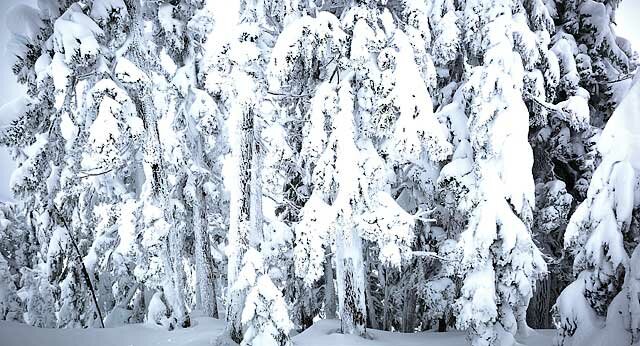 |
| By Erik Burge Photo by Jay GoodrichThree of us decided to take a shortcut traverse across an exceedingly steep pocket meadow while we were boot packing to our favorite powder stash up on Church Mountain one frozen, early-spring morning. None of us will ever forget it. The sky was disarmingly clear, the snow pack on the side slope was all kinds of crusty and, thanks to the fact that we were completely hemmed in by four solid walls of well-anchored timber, our avalanche exposure was only semi-sketchy at worst. After post-holing two hours straight uphill through heavy timber (starting out from our cabin near Glacier) there appeared little cause for anyone in our snowboard-encumbered ascent party to consider this sunny little opening in the canopy anything less than a blessing. Unfortunately, the one terrain-induced hazard we neglected to observe was the ice-encrusted profusion of snow-loaded tree branches that were primed and ready to come raining down at even the slightest, hair-trigger touch from the timber wall crowning the meadow above. The first breeze stirred gently and did not linger – just a soft, cool kiss on our hot, sweaty brows. Certainly nothing to worry about. Or so we thought. “Man!” exclaimed our leader, halting abruptly to absorb as much of this seemingly benign atmospheric sensation as she could. “Doesn’t this little riffle feel fantastic?” It was then that first icy snow blob came shooting downhill right behind me, zooming so fast through my peripheral vision that I thought at first it was just a grey jay dive-bombing for crumbs. “Look out!” I shouted to my partners, purely in jest. “We’re being attacked!” And that’s when the next, much bigger icy snow blob the size of a beach ball came spitting out of the forest to score a direct hit, rolling so severely into the exposed mid-section of the six-foot-tall, 250-pound snowboarder directly ahead of me that he crumpled into a free-fall. While this unfortunate fellow went tumbling like a human bowling pin down into the trees far below – he suffered three broken ribs and temporary hearing loss – my remaining partner and I anticipated the coming catastrophe and promptly ratcheted ourselves into evasive action mode. Setting our sights on the sheltering timber wall 30 feet ahead, we dropped down on all fours and started to crawl for it. But the faster we tried to crawl, the deeper we kept sinking into the snow. Finally, once we’d become mired neck-deep still about 20 feet shy of our safety zone, the strongest load-releasing breeze yet came blowing through the trees, releasing dozens upon dozens of snow projectiles down the hill all around us. There was no escape. “Take off your pack!” my partner screamed, just as the biggest wind-born projectile of all, roughly the size of two to three beach balls combined, came whooshing right between our heads with only inches to spare. Shielding myself with a Burton 165 seemed ridiculous, but it was absolutely the right thing to do. I only managed to yank one arm out of my straps before a rock-hard ice-football smacked so violently into the protruding nose of my board that it flipped the thing over my head and cracked it clean through, edge to edge. All told, that little shortcut we took quickly turned into one of the longest, most excruciating traverses I’ve ever made. Yet, even when you figure in subsequent hospital bills and equipment repairs, the invaluable hazard assessment lessons we learned up there pretty much caused us to break even, I think. Seldom, if ever, do I take shortcuts in the North Cascade backcountry. And my vigilance for detecting potentially dangerous snow blob accumulations, whether they are hiding up in the trees or lurking somewhere down on the ground, remains as constant as the terrain and weather conditions are changing. X Erik Burge has been flirting with disaster ever since his grandfather strapped him into his first pair of skis and sent him hurtling down the only hill in the entire state of North Dakota at the tender age of four. Fortunately, the first time he ventured into the Mt. Baker backcountry was not his last. |